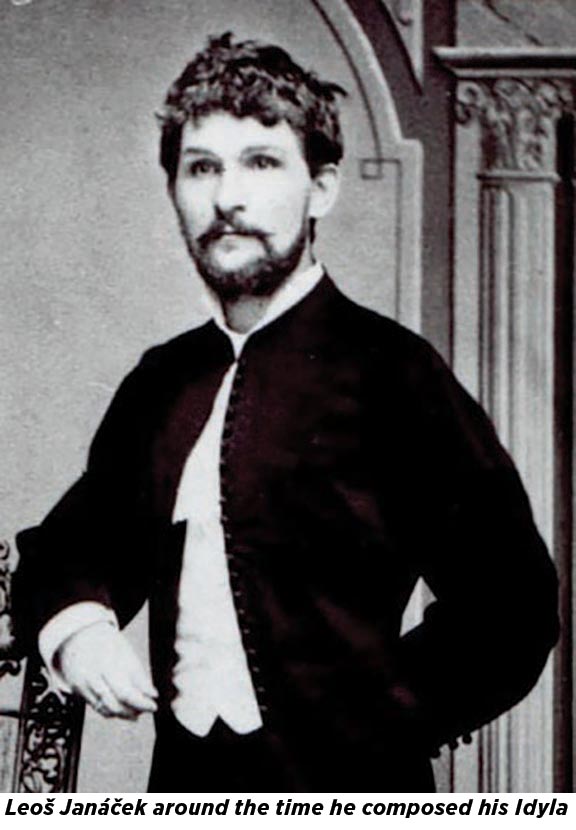Composed 1878; 28 minutes
 Leoš Janáček was in his late forties before his opera Jenůfa revealed a musical voice he had spent years developing, then refining. The opera’s première in Brno, after almost a decade of composition, came in January 1904, just before his 50th birthday. It was to be another 12 years before Jenůfa reached Prague. Only then did this truly national Moravian opera bring wider recognition to a composer with something unique to say to the world. Following its triumph, in a glorious 12-year Indian summer, Janáček rapidly created more operas (Kat’a Kabanová, The Cunning Little Vixen, The Makropoulos Affair, From the House of the Dead), and the powerful Glagolitic Mass, the Sinfonietta and two graphic string quartets. Before arriving at the peak of his productivity, Janáček, born the ninth of 14 children in a family of a village schoolteacher/musician in rural Moravia, had long directed choirs. He also worked simultaneously as organist, music teacher at the Brno Teachers’ Training Institute as well as founder and director of the city’s Organ School (later Conservatory).
Leoš Janáček was in his late forties before his opera Jenůfa revealed a musical voice he had spent years developing, then refining. The opera’s première in Brno, after almost a decade of composition, came in January 1904, just before his 50th birthday. It was to be another 12 years before Jenůfa reached Prague. Only then did this truly national Moravian opera bring wider recognition to a composer with something unique to say to the world. Following its triumph, in a glorious 12-year Indian summer, Janáček rapidly created more operas (Kat’a Kabanová, The Cunning Little Vixen, The Makropoulos Affair, From the House of the Dead), and the powerful Glagolitic Mass, the Sinfonietta and two graphic string quartets. Before arriving at the peak of his productivity, Janáček, born the ninth of 14 children in a family of a village schoolteacher/musician in rural Moravia, had long directed choirs. He also worked simultaneously as organist, music teacher at the Brno Teachers’ Training Institute as well as founder and director of the city’s Organ School (later Conservatory).
Janáček frequently programmed the music of Dvořák with the civic choir, the Beseda, of which he rapidly cultivated its modest male-voice origins to an ambitious mixed-voice choral society. His newly founded orchestra and violin school provided the instrumental support. Dvořák’s Serenade for strings, Op. 22, soon appeared on its programming. Janáček first met Dvořák, 13 years his senior, while studying in Prague. Their friendship developed, and, in 1877, they took a train and walking tour of southern Bohemia together, visiting culturally significant places. Janáček saw his hopes for Czech music embodied in Dvořák, with his rising international profile. “All [Dvořák’s] melodies grow out of the same soil as folk songs,” Janáček wrote some years later in a series of articles on his colleague’s symphonic poems.
The hallmarks of Dvořák’s ‘Slavonic’ idiom percolate through the seven-movement Idyll Janáček composed in August 1878. This is Janáček’s second surviving large scale instrumental piece; he conducted the six-movement Suite for strings in a Beseda concert in December of the previous year. In both, we hear Janáček, still in his early twenties, searching for an individual musical voice, avoiding the obvious (no folk tune has been harmonized during the production of these pieces!), drawing out ‘Slavonic’ coloring, sometimes via Dvořák, Smetana or Tchaikovsky, sometimes from its source. The folk song influence is, perhaps, strongest in the even numbered movements: No. 2 with its off-beat accents, lyrical folk song-like fragments and abrupt rhythmic shift in its mid-section; No. 4 with its rustic, ever-shifting major-minor tussle; No. 6 with the fresh-as-a-daisy innocence of its imitative four-bar phrasing.
Overall, the A-B-A song form predominates, though the closing sections often rework the initial presentation, ensuring none of the movements overstay their welcome. No. 3 reaches deep, sorrowfully swaying to an unusual five-beat rhythm. No. 5 is a dumka, with dark-hued grieving bookending a brief, brighter, busy center section. Janáček’s confidence abounds in the intricate, sonorous string writing of No. 7, spiced with off-the-beat accents drawn from the folk music that would soon begin to embed itself into the composer’s musical language.
— Janacek program notes copyright © 2024 Keith Horner. Comments welcomed: khnotes@sympatico.ca